CFP: Exploring Experiences of Repression in the Soviet Union and Communist Eastern Europe (Leeds, January 2017)
CALL FOR PAPERS
EXPLORING EXPERIENCES OF REPRESSION IN THE SOVIET UNION AND COMMUNIST EASTERN EUROPE.
DATE: Friday 20th January 2017
VENUE: Leeds Beckett University, Leeds, UK.
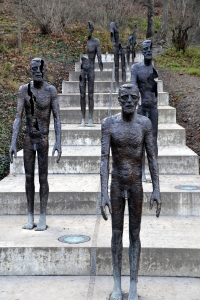
Memorial to the Victims of Communism (Prague, Czech Republic)
SUMMARY
In recent years there has been renewed academic interest in studying experiences of repression in the former communist bloc as scholars increasingly recognise the need to move beyond previously narrow definitions of communist ‘terror’ and ‘repression’ to reflect better its multifaceted political, ideological and socio-economic dimensions. Today, while we know more about the politics of the purges, we know significantly less about the impact of the repressions as an everyday experience. In addition to continued focus on directly enforced aspects of state repression (including arrests, executions, non-judicial murders, show trials, mass deportations and incarceration in penal institutes and forced labour camps), recent studies have emphasised the impact of practices such as more general police surveillance, enforced conscription, confiscation of property, eviction from dwellings, loss of employment and social status.
Since 1989, with the collapse of the socialist regimes in Eastern Europe, and 1991, with the collapse of the communist regime in the Soviet Union, a good deal of new material has become available about the repressive nature of these regimes and the impact this had on those who suffered under them. Today, historians have access to a wider range of source materials including recently released archival documentation, contemporary and historical newspaper reports, autobiographies/biographies, published testimonies of survivors and their family members, photographs and film. There has also been increased emphasis on oral history, due to concerted efforts to record individual experiences of repression, as many of those who experienced communist-era repression are nearing the ends of their lives.
If you would like to participate then please send proposals consisting of paper title, a brief (250 words) abstract and presenter’s details to Dr. Kelly Hignett at K.L.Hignett@Leedsbeckett.ac.uk by Monday 19th December.
Women and Repression in Communist Czechoslovakia
Today’s blog post, written for International Women’s Day 2016, relates to my current research into women’s experiences of repression in communist Eastern Europe, with a particular focus on Czechoslovakia 1948-1968, during the period of Stalinist terror and its immediate aftermath.
The vast majority of the 90,000 – 100,000 Czechoslovak citizens who were prosecuted and interned for political crimes between 1948-1954 were men; only between 5,000 – 9,000 (5-10%) were women. These women were held in numerous different prisons and forced labour camps across Czechoslovakia, where they frequently experienced poor living conditions, inadequate hygiene and medical care and enforced labour, while enduring physical and psychological violence, abuse and humiliation at the hands of the penal authorities. Beyond this, however, hundreds of thousands of other Czechoslovakian women also became ‘collateral’ victims of state-sanctioned repression during these years. The Czechoslovakian Communist Party actively pursued a policy of ‘punishment through kinship ties’, so while family members of those incarcerated for political crimes were not necessarily arrested themselves, they were considered ‘guilty by association’. As men comprised the majority of political prisoners, it was usually the women who were left trying to hold their families together and survive in the face of sustained political and socio-economic discrimination, marginalisation and exclusion.
The growth in published memoirs and oral history projects such as Paměť Národa and Političtívězni.cz in post-communist Czech Republic and Slovakia have encouraged more victims of repression to record their stories. However, women’s experiences of political repression in communist Czechoslovakia remain under-researched and under-represented in the historiography. It is often suggested that women are generally more reluctant to share personal accounts of traumatic experiences, in comparison with their male counterparts. For example Historian Tomáš Bursík’s study of Czechoslovakian women prisoners Ztratili jsme mnoho casu … Ale ne sebe! notes that in many cases ‘Women do not like to return to their suffering, that misfortune they affected, the humiliation that followed. They do not want to talk about it’. In her own account of imprisonment in communist Czechoslovakia, Krásná němá paní, Božena Kuklová-Jíšová also explained that:
‘We women are very often criticized for not writing about ourselves, about our fate. Perhaps it is because there were some moments which were very humiliating for us; or because in comparison to the many different brave acts of men, our acts seem so narrow-minded. But the main reason is that we have difficulties presenting ourselves to the world’.
This reticence extends to many women who experienced collateral or secondary repression, such as Jo Langer, who despite being subjected to sustained political harassment and socio-economic discrimination including loss of employment and forced relocation when her husband Oscar was arrested and interned 1951-1960, described how, upon receiving the first full account of her husband’s traumatic experiences in the camps after his release, she felt ‘shattered and deeply ashamed of having thought myself a victim of suffering’ (You can read more about Jo Langer’s autobiography Convictions: My Life with a Good Communist in my previous blog post HERE)
However, the inclusion of women’s narratives make an important contribution to the historiography, broadening and deepening our understanding of terror and repression in communist Eastern Europe. A number of women who endured political repression have shared their stories, which not only document their suffering at the hands of the Communist Party but are also testimony to their strength, resistance and will to survive. Through their narratives, these women are able to present themselves simultaneously as both victims and survivors of communist repression.
Today then, it seems fitting to mark International Women’s Day 2016 by briefly highlighting two examples to pay tribute to the many strong, spirited and inspiring women who feature in my own research.
Dagmar Šimková
“The screeching seagulls are flying around me. I am so free, I can walk barefoot. And the waves wash away traces of my steps long before a print could be left”.

Dagmar Simkova’s arrest, official photograph (1952). Source: http://zpravy.idnes.cz/autorka-svedectvi-o-zenskych-veznicich-krasna-a-inteligentni-dagmar-simkova-by-se-dozila-80-let-i1u-/zpr_archiv.aspx?c=A090522_114346_kavarna_bos
Dagmar Šimková’s autobiographical account of her experiences in prison Byly jsme tam taky [We were there too] is arguably one of the strongest testimonies of communist-era imprisonment to emerge from the former east bloc. Šimková’s family became targets after the communist coup of 1948 due to their ‘bourgeois origins’ (her father had been a banker). Their villa was confiscated by the Communists, while Dagmar and her sister Marta were denied access to university. While Marta fled Czechoslovakia in 1950, Dagmar became involved in resistance activities, printing and distributing anti-communist leaflets and posters mocking the new Czechoslovakian leader, Klement Gottwald. In October 1952, following a failed attempt to help two friends avoid military service by escaping to the West, she was arrested, aged 23, and sentenced to fifteen years in prison.
Between 1952 – 1966 Šimková passed through various prisons and labour camps in Czechoslovakia: in Prague, Pisek, Ceske Budejovice and Opava. In 1955 she even briefly escaped from Želiezovce, a notoriously harsh agricultural labour camp in Slovakia. Sadly, her freedom was shortlived: she was found sleeping in a haystack at a nearby farm two days later, recaptured and returned to Želiezovce, where an additional three years was added to her existing prison term as a punishment.
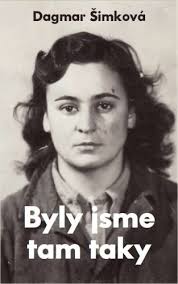
Dagmar Simkova’s book Byly Jsme Tam Taky [“We Were There Too”]
From 1953, Šimková was held in Pardubice Prison near Prague, in the women’s department ‘Hrad’ (Castle), which was specially created to house 64 women who were perceived as being the ‘most dangerous’ political prisoners, and segregate them from the main prison population. Here, Šimková participated in several organised hunger strikes to demand better conditions for women prisoners. She was also an active participant in the ‘prison university’ founded by former university professor Růžena Vacková, who gave secret lectures on fine art, literature and languages to her fellow prisoners. Šimková later described how ‘We devoured every word. We tried to remember, and understand, like the best students at universities’. Some of the women even managed to compile some lecture notes into a small book which was secretly hidden, before being smuggled out of Pardubice in 1965. This book is currently held in the Charles University archives.
After a total of fourteen years incarceration, Dagmar Šimková was finally released in April 1966, aged 37. Two years later, during the liberalisation of the Prague Spring in 1968 she was instrumental in establishing K 231, the first organisation to represent former political prisoners in Czechoslovakia. Following the Soviet invasion to halt the Czechoslovak reforms, Šimková emigrated to start a new life in Austrialia, where she completed two University degrees, worked as an artist, prison therapist and even trained as a stuntwoman! She also worked with Amnesty International , continuing to campaign for better prison conditions until her death in 1995.
Heda Margolius Kovály
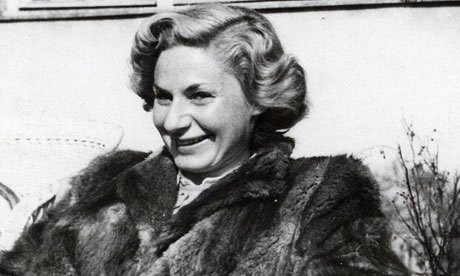
Heda Margolius Kovaly. Source: http://www.theguardian.com/theguardian/2010/dec/13/heda-margolius-kovaly
Heda Margolius Kovály’s memoir, Under A Cruel Star: A Life in Prague 1941-1968 remains one of the most damning accounts of the violence and repression that characterised mid-twentieth century central and eastern Europe. Heda’s incredible life story spans the Nazi concentration camps, the devastation of WWII, the communist coup and the post-war Stalinist terror in Czechsolovakia. Having survived Auschwitz, Heda escaped during a death march to Bergen-Belsen and managed to make her way home to Prague. After the war, she was reunited with her husband Rudolf Margolius, who was also a concentration camp survivor, and a committed communist. Following the Communist coup of February 1948, Rudolf served as Deputy Minister of Foreign Trade, only to quickly fall victim to the Stalinist purges. Rudolf was arrested on 10 January 1952, brutally interrogated and forced to falsely confess to a range of ‘crimes’ including sabotage, espionage and treason. He was subsequently convicted as a member of the alleged ‘anti-state conspiracy’ group led by former General Secretary, Rudolf Slansky, in Czechoslovakia’s most infamous show trial. In December 1952, Rudolf was executed, along with 10 of his co-defendents.
Following Rudolf’s arrest, Heda described how ‘Suddenly, the world tilted and I felt myself falling … into a bottomless space’ . She was left to raise their young son, Ivan, while fighting to survive in the face of sustained state-sanctioned repression. She was swiftly fired from her job at a publishing house, and was forced to work extremely long hours for pitifully little pay, while living on ‘bread and milk’ in order to make enough to cover their basic needs. Her savings and most of her possessions were confiscated, and she and Ivan were forced to leave their home and move to a single room in a dirty and dilapidated apartment block on the outskirts of Prague, where it was so cold that ice formed inside during the winter months, and cockroaches ‘almost as large as mice’ crawled up the walls. Abandoned by most of her former friends, Heda describes how she became a social pariah who was treated ‘like a leper’. At best, former friends and acquaintances would ignore her when they passed in the street, while others would ‘stop and stare with venom’ sometimes even spitting at her as she walked by.
The strain of living under these conditions caused Heda to become critically ill, but she was initially denied medical treatment. When she was finally admitted to hospital she had a temperature of 104 and a long list of ailments, leading the doctor who treated her to compare her to a newly released concentration camp survivor. It was while she was recovering in hospital that she heard Rudolf’s trial testimony broadcast on the radio, and she listened to her husband monotonously admit to ‘lie after lie’ as he recited the script he had been forced to learn. Forcibly discharged from hospital before she was fully recovered, Heda was so weak that she had to crawl ‘inch by inch’ from the front door of her apartment block to her bedroom, where she spent several weeks following Rudolf’s execution ‘motionless, without a thought, without pain, in total emptiness … lying in my bed as if it were a coffin’.
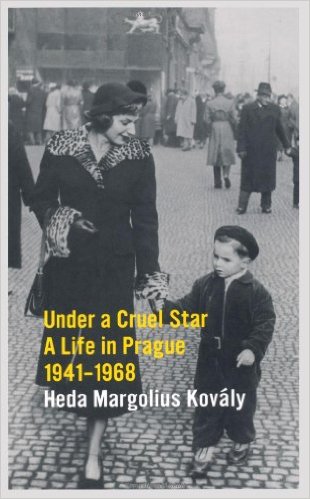
‘Under a Cruel Star: A Life in Prague 1941-1968’ is Heda Margolius Kovaly’s account of surviving Nazi and Communist persecution.
Nevertheless, Heda regained her strength. Her son Ivan later described how, even in the face of sustained persecution ‘Heda survived through her determination and managed to look after us both’. She continued to maintain Rudolf’s innocence and fought to clear his name, writing endless letters and attempting to arrange meetings with various communist officials, most of whom refused to see her. Following Rudolf’s execution, she dared to publicly mourn him by dressing completely in black, in a deliberate challenge to the Communist Party. After she remarried in 1955, she continued to campaign for Rudolf’s full rehabilitation. In April 1963, she was finally summoned to the Central Committee where Rudolf’s innocence was privately confirmed, and Heda was asked to write a ‘summary of losses’ suffered as a result of his arrest and conviction, so that she could apply for compensation. In Under a Cruel Star, she described how:
‘I sat down at my typewriter and typed up a list:
– Loss of Father
– Loss of Husband
– Loss of Honour
– Loss of Health
– Loss of Employment and Opportunity to Complete Education
– Loss of Faith in the Party and JusticeOnly at the end did I write:
– Loss of Property’.
Upon presentation of this list, the Communist officials responded in confusion:
‘”But you must understand that no one can make these losses up to you?”. “Exactly” I said “That’s why I wrote them up for you, So that you know that whatever you do you can never undo what you have done … you murdered my husband. You threw me out of every job I had. You had me thrown out of a hospital! You threw us out of our apartment and into a hovel where only by some miracle we did not die. You ruined my son’s childhood! And now you think you can compensate for that with a few crowns? Buy me off? Keep me quiet?”.’
Following the failed Prague Spring and the Soviet invasion of Czechoslovakia in August 1968, Heda left Czechoslovakia and settled in the USA with her second husband, Pavel Kovály. There, she continued to forge a successful career as a translator in addition to working as a librarian in the international law library at Harvard University. Heda Margolius Kovály died in 2010, aged 91. In addition to her personal memoir Under A Cruel Star, an English-language translation of Heda’s novel Nevina [Innocence] was recently published in 2015 – which I can also highly recommend!
‘Endut! Hoch Hech!’: Confronting Stereotypes About Everyday Life In Communist Eastern Europe.
“ENDUT! HOCH HECH!”: CONFRONTING STEREOTYPES ABOUT EVERYDAY LIFE IN COMMUNIST EASTERN EUROPE – BY CHRIS PRINCE.
Fans of The Simpsons will instantly recognise the titular quote as the caption at the end of this cartoon: ‘Eastern Europe’s favourite cat and mouse team’: Worker and Parasite. Although a rather novel example, ‘Worker and Parasite’ embodies many popular Western stereotypes about communist Eastern Europe. The booming drums and out of tune piano creates a picture of oppression and backwardness; the identical downtrodden men the duo pass by leave an impression of a poverty-stricken and monotonous existence; and the language used is utter gibberish, attributing a sense of incomprehensibility to communism, which is further compounded onscreen by Krusty the Clown’s comment: ‘What the hell was that?’
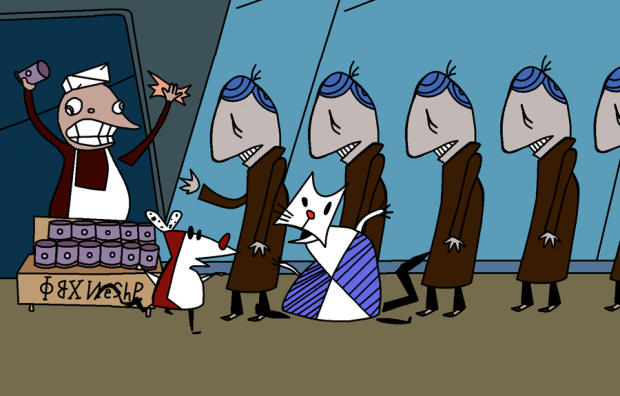
‘Worker and Parasite’ – ‘Krusty Gets Kancelled.’ (1993), The Simpsons, Season 4,Twentieth Century Fox.
However, was life behind the iron curtain as uniformly grey, bleak and oppressive as is commonly thought? The recent rise of ‘ostalgie’, coupled with the regular publication of survey data claiming that many people believe that at least some aspects of their lives were better under communism, suggests not. There has been growing academic interest in documenting, analysing and attempting to understand experiences of everyday life in communist Eastern Europe in recent years. Today, historians have access to a growing collection of memoirs, interviews and personal testimonies, providing us with a range of first-hand accounts, perspectives and insights about life ‘behind the iron curtain’. When read critically and comparatively, these stories can provide us with a more nuanced, comprehensive understanding of the complexities of everyday life in communist Eastern Europe, as well as challenging some aspects of the most popular stereotypes.
One prominent image that comes to mind when thinking about Communist Eastern Europe is that of widespread material deprivation and poverty. Indeed, the available data shows that by 1973 the economy of East Europe was lagging far behind the West, with the GDP of all Eastern states 30 to 66 percent below the US level . This situation had worsened further by the 1980s, as the many photographs of sparsely stocked shelves and long queues of sad-looking customers standing outside state stores attest. Even when state stores did receive a delivery, many customers complained about the lack of choice available. While Communist Party membership provided access to special socio-economic ‘privileges’ for a select few, economic conditions for the majority were relatively poor, and many individuals highlight material deprivation as a dominant theme when remembering their lives under communism. For example, Simona Baciu described how she could not afford to buy her children any toys, so she collected shoe linings and stripped an old dress to make them stuffed elephants. Baciu also detailed how she and her family had to spend the Romanian winters ‘huddled together next to the stove to gain warmth from each other’ (Baciu in Shapiro, 2004, p.37; p.41). Slavenka Drakulic also explained how private ownership of luxury goods, such as a washing machine, was widely viewed as a marker of economic prestige and social status (Drakulic, 1987, p49).
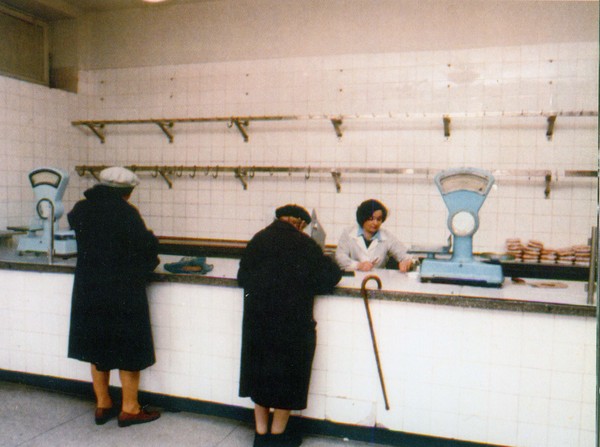
Shopping behind the iron curtain could be a frustrating and time consuming experience! Photo showing empty shelves in Warsaw (1982). Source: http://chnm.gmu.edu/1989/archive/fullsize/Sklep%20miesny,%20Warszawa,%201982,%20by%20Chris%20Niedenthal_2f1befa84f.jpg
However, while many testimonies acknowledge the material deprivation people endured under communism, they also provide some fascinating insights into the ways in which East Europeans coped with the burdens of life in a shortage economy. For example, while Janine Wedel describes the existence of ‘long queues and line committees’ outside empty state stores, she also provides a detailed account of the mechanisms of the informal economy that developed across Eastern Europe in response to economic scarcity, highlighting the etiquette and courtesies required for the establishment of successful ‘Zalatwic’, a complex system of favour exchange, that provided access to goods in short supply. In Wedel’s case, one personal example involved her wooing a local shopkeeper by agreeing to provide her with expensive American coffee to secure the sale of a high quality leather briefcase that was officially ‘out of stock’. As a result of her own experiences, Wedel came to the conclusion that ‘Contrary to the Western perception that no one in Poland can get anything, almost everyone can get something’ – at least, if they were willing to ‘Zalatwic’ (Wedel, 1986, p36; p45).
Wedel also painted a fairly unflattering picture of employment conditions in communist Eastern Europe, characterised by the existence of a generally ‘lackadaisical’ attitude towards work, with employees lazing on the job, cutting their hours short and regularly calling in sick. The popular attitude towards state employment in Eastern Europe was summed up by a well-known communist-era saying “They pretend to pay us, and we pretend to work”. However, Wedel stresses that such ‘lazy’ attitudes applied only to employment within the ‘official’ or state economy, where the lack of motivation and productivity could be explained due to low wages and under-employment. Her study also revealed the enormous time, effort and energy many individuals put into their ‘secondary jobs’ (moonlighting) because they were ‘working for themselves’ in exchange for additional ‘unofficial’ (illegal) income, which was necessary for most people to make ends meet (Wedel, 1986, pp.63-66).
The kind of passive apathy demonstrated towards the state in the workplace was often manifest more openly in the privacy of the home. While the majority of citizens displayed a reasonable level of public conformity, in the relative safety of the private sphere people generally felt more comfortable expressing their discontent and dissatisfaction. Heda Margolius Kovály explained how: ‘During the day people put in their hours at work and fulfilled their party obligations; then they went home, removed their masks, and began to live for a few hours’ (Kovaly, 1986, p.166). Daniela Draghici detailed how people would gather together in their communal kitchens to ‘talk against the government’ and expressed that this kind of ‘private resistance’ was necessary in order to ‘survive communism’ (Draghici in Molloy, 2008). Drakulic also described how, in the Eastern bloc, ‘we are used to swallowing politics with our meals … at dinner you laugh at the evening news, or get mad at the lies that the Communist Party is trying to sell, in spite of everything’ (Drakulic, 1987, pp.16-17). Similarly, resistance could be demonstrated through ‘harmless’ political jokes aimed at the government, which Ben Lewis claimed helped, in part, to ‘laugh communism out of existence’ (Lewis, 2008).
Another popularly held idea about life in communist Eastern Europe, is the perception of an oppressive and ‘grey’ society. Geoffrey and Nigel Swain have argued that by the 1980s, for many East Europeans communism was characterised by ‘the grey Brezhnev years of cynicism, corruption, shortage and falling living standards’ (Swain and Swain, 1993, p.201). Marius Mates, agrees, remembering the commonality of depression; that ‘everybody was so unhappy’ under communism (Mates in Shapiro, 2004, p.79) . Similarly, Slavenka Drakulic argued that the ‘banality of everyday life’ was one of the central fallings of the communist state (Drakulic, 1987, p.18). However, this negative view is tempered by many other individuals who provide more positive accounts of their experiences of life behind the Iron Curtain. For instance, Paula Kirby, a writer who moved to East Germany during the early 1980s, found herself taken aback by the beauty of the urban landscapes and the ‘mass appeal’ the high arts of theatre and opera had obtained due to its accessibility and affordability – a result of generous state subsidies. Zsuzsanna Clark also described fond memories of her schooldays, praising the standard of education that was freely available in communist Hungary, and enthused over her family’s annual vacations to Lake Balaton, emphasising that luxuries such as holidays were only available to many Hungarians because of Communist Party initiatives which had ‘opened up leisure and holiday opportunities…for all” . Similarly parts of Oliver Fritz’s narrative paint a rather idyllic picture of his childhood in East Germany, as he recounts happy memories of time spent playing with friends, sipping fizzy orange lemonade on allotments; helping old ladies cross the street as a proud pioneer (the East German equivalent of the British scouts) ; as well as pulling pranks in the centre of East Berlin by ‘dressing up and acting as lost Westerners’ (Fritz, 2009, p.33; p.46).

Zsuzsanna Clarke playing with her cousins during her happy childhood in communist Hungary. Source: http://www.dailymail.co.uk/news/article-1221064/Oppressive-grey-No-growing-communism-happiest-time-life.html
A perpetual housing shortage meant there were long waiting lists for accommodation, so several generations of the same family were often forced to co-habit for extended periods, enduring communism, warts and all, together. This often bought people closer, creating stronger family ties and a stronger sense of community, although for others it was problematic. Drakulic argues that the ‘enforced closeness’ of families ultimately had a detrimental effect, ‘infantilizing’ the younger generation and stifling their will to protest in a ‘geriatric society’ (Drakulic, 1987, pp.88-89). Women’s accounts of their experiences under communism are also notably mixed. Many have praised the increased liberties and the expansion of paid work for women during the communist period. Marie-Luise Seidel, for example, applauded the communist state for the financial support she received as a single mother (Seidel in Molloy, 2008). Nonetheless, as Barbara Einhorn details, despite their increased employment, many did not receive any alleviation from their traditional gender role and therefore endured a ‘dual’ burden in society. For example, Natalia Baranskaya remembers how she endured discrimination at work alongside the burden of caring for her home and family (Einhorn, 1993, pp.46-52) However, many individuals have suggested that the hardships they endured under communism ultimately resulted in the creation of a stronger bond between family and friends, speaking wistfully of the ‘spirit of camaraderie’ that had once prevailed under communism. Similarly, John Feffer has argued that some people now look back on their time during communism, as the “calm life” because: “You generally didn’t have to work hard. You didn’t have to worry about losing your job. Life was simpler. There was only one kind of washing powder. You could count the number of television channels on one hand.”
The process of sharing personal memories is always selective, and we need to bear in mind that individual accounts of life under communism have been influenced by contemporary experiences of post-communism as much as by the ‘reality’ of the past. However, the range of personal experiences and memories highlighted above shows that we need to guard against accepting generalised or over simplified stereotypes about life behind the iron curtain. At times personal testimonies support the conventional image of communist Eastern Europe as grey, depressed, oppressive and poverty stricken. In other ways however, they contrast or even challenge many of these accepted stereotypes, illustrating that sometimes people not only survived communism but benefited from it. Personal narratives attest to the many complexities of navigating life behind the iron curtain, enabling us to gain a deeper understanding of life in communist Eastern Europe, while also reconsidering certain aspects of its more conventional image.
ABOUT THE AUTHOR
CHRIS PRINCE has recently completed his BA (Hons) in History at Leeds Beckett University, graduating with first class honours in July 2015. During his final year of study, Chris studied Communist Eastern Europe and he researched experiences of everday life in Eastern Europe for one of his assessed essays. Chris is now planning to study for an A+ certification.
SOURCES
‘Krusty Gets Kancelled’ (1993) The Simpsons, Season 4, Twentieth Century Fox.
Clark, Z. (2009) ‘Oppressive and Grey? No, growing up under communism was the happiest time of my life.’ Daily Mail 17/10/2009, http://www.dailymail.co.uk/news/article-1221064/Oppressive-grey-No-growing-communism-happiest-time-life.html
Drakulic, S. (1987) How we Survived Communism and Even Laughed. London: Vintage.
Einhorn, H. (1993) Cinderella Goes to Market: Citizenship, Gender and Women’s movements in East Central Europe. London: Verso.
Feffer, J (2013) ‘Remembering the Calm Life Under Communism’, The Huffington Post 02/12/2013, http://www.huffingtonpost.com/john-feffer/remembering-the-calm-life_b_2671955.html
Fritz, O. (2009) The Iron Curtain Kid. Raleigh: Lulu Press. See also: http://www.ironcurtainkid.com/
Kirby, P and Hignett, K. (2014) ‘Paula Kirby on Life in the GDR’ The View East, https://thevieweast.wordpress.com/2014/02/14/paula-kirby-on-life-in-the-gdr/
Kovály, H.M. (1986) Under a Cruel Star: A Life in Prague. 1941-1968. London: Granta.
Lewis, B. (2008) Hammer and Tickle: A History of Communism Told Through Communist Jokes. London: Phoenix.
Molloy, P. (2008) The Lost World of Communism: A History of Daily Life Behind the Iron Curtain. BBC Worldwide.
Shapiro, S.G. (2004) The Curtain Rises: Oral Histories of the Fall of Communism in Eastern Europe. London: McFarland and Company, Inc. Publishers.
Swain, G and Swain, N. (1993) Eastern Europe Since 1945. New York: Palgrave MacMillan
Wedel, J. (1986) The Private Poland. New York: Facts on File.
-
Archives
- November 2016 (1)
- March 2016 (1)
- July 2015 (4)
- November 2014 (2)
- October 2014 (1)
- September 2014 (1)
- June 2014 (1)
- February 2014 (1)
- December 2013 (1)
- October 2013 (2)
- August 2013 (2)
- July 2013 (1)
-
Categories
-
RSS
Entries RSS
Comments RSS
